
Ethiopia has abundant livestock population. And it holds the largest livestock population in Africa. This livestock population has been contributing its part to the country’s economic development and Borana zone of Oromia region is the major contributor in this regard.
Borana Zone is the epicenter of this population making a significant contribution to the Gross Domestic Product (GDP) of the country. According to 2015 population and housing census, the wellbeing of over half million Borana Zone populations are depended on their livestock resource.
According to the Zonal administration’s recent data, Borana has about 6.8 million livestock population. However, this livestock wealth is highly constrained by the infestation of Tsetse fly (in Amharic it is called ye kola zinb) and Trypanosomiasis prevalence (ye gendi beshita). In Elwoya district alone, 60 percent of clinical cases among livestock treated in the animal health clinic. The disease has resulted in significant losses of cattle and camel production and productivity.
The International Center of Insect Physiology and Ecology (icipe) and its partners embarked on addressing the challenges of pastoralists through implementing effective, affordable and environmentally friendly tsetse and trypanosomiasis management technologies. The effects of the technologies will have a significant impact on improving animal health and income as well as the food security of the agro pastoral community. The project funded by Swiss Agency for Development and Cooperation (SDC) implemented by icipe in partnership with local partners.
Since December 2020, icipe has been demonstrating three types of technologies to control tsetse fly in Elwoya, Taltelle, and Dillo districts of Borana Zone. The technologies include collar repellents, odor baited traps and targets. The project implementation and its outcomes were observed during the stakeholders’ exchange and on field visit paid at Sabu and Sarite Villages of Elwoya district, where the technologies for combating Tsetse Fly demonstrated recently.
Dr. Kasim Guyo, Borana Zone, Livestock Resource Development Head told The Ethiopian Herald that Borana is known by vast sources of livestock. It hosts nearly 7 million livestock population but the infestations of a tsetse fly affecting the production and productivity of the livestock.
“We tried our best to find the solution. The community also spent lots of money on purchasing drugs, but we could not help to control the infestation. Consequently, pastoralists are migrating to other areas due to the problem but technologies provided by icipe firmly effective in eliminating infestation and disease once and for ever. Hence, it is really a lifesaving project,” Dr. Kasim said.
Bokayu Guracha, a female pastoralist in Sabba village of Elwoya district for her part, said that before the introduction of this technology, they had serious problems with the tsetse fly. Even, last year, they lost many of their cattle. It affects almost all of their domestic animals. Following this; fertility rate of a cattle and its productivity were reduced besides poor growth, weight loss, frequent abortion, and death of the cattle. To save their cattle thus, they attempted to buy drugs but couldn’t get easily on the market and even when they accessed it, the price was too much to afford. Hence, they were frustrated and began selling their cattle and camels.
But, the icipe, back hopes for pastoralists through these technologies she said adding: “If these traps are not available now, it would be hard to stop over here for a minute because the area was fully covered by tsetse flies but icipe helped and surprised us to see the traps catching many tsetse flies. This is a great achievement that gives a relief for us and our cattle’s.”
Letifo Molu, a scout in Sarite village said that every year, over 1,000 cattle were killed in their village due to tsetse fly and for years the grazing land has been conquered by the tsetse flies making it hard to suit for grazing. Therefore, they used to avoid their cattle grazing there due to high tsetse infestations but at the moment, thanks to the project, there is less fly around.
“I received training about the benefits of the technologies especially about tsetse trap and engaged during the trap deployment. Last time we saw the traps full of tsetse flies and other insects now, the infestation tremendously reduced, and the cattle are back to this grazing area,” he said.
Kancoro Tuto, from Teltelle district on his part said: “We are pastoralists where our food security is dependent on our cattle. But due to trypanosomosis, our cattle have died. We always spend high for the treatment and to buy drugs. Following the training and awareness provided by the icipe on the importance of these technologies, I have been actively involved in mobilizing the community to participate in traps deployment. Look at the tsetse flies in this trap, they would have a bite and infect our cattle. We hope the technology will reduce tsetse flies’ population and trypanosomosis.”
Dereje Kusa, the Research Officer, icipe for his part said that they are performing very well in demonstrating tsetse control technologies especially by combining traps and repellent technologies for pastoral and agro pastoral communities. A strategic intervention and the technologies deployed so far have contributed to the reduction of tsetse infestation and simplified the burden of the community.
The project targets to reach 500 direct beneficiaries in Borana Zone. Besides, it has raised public awareness, provided capacity building training for animal health workers, community owned resource persons and deployed tsetse control technologies at every hotspot area. He ascribed adding that Pastoralists are now taking their cattle to grazing areas because no fear of tsetse bites. There is also high adoption of technologies by the community in the project intervention areas.
Following remarkable achievement of the project, the local government in Borana Zone recognized and provided an award of excellence certificate to icipe and SDC for their pioneering contribution to integrated management of Tsetse and Trypanosomosis.
BY MULATU BELACHEW
ETHIOPIAN HERALD 17 SEPTEMBER 2021





